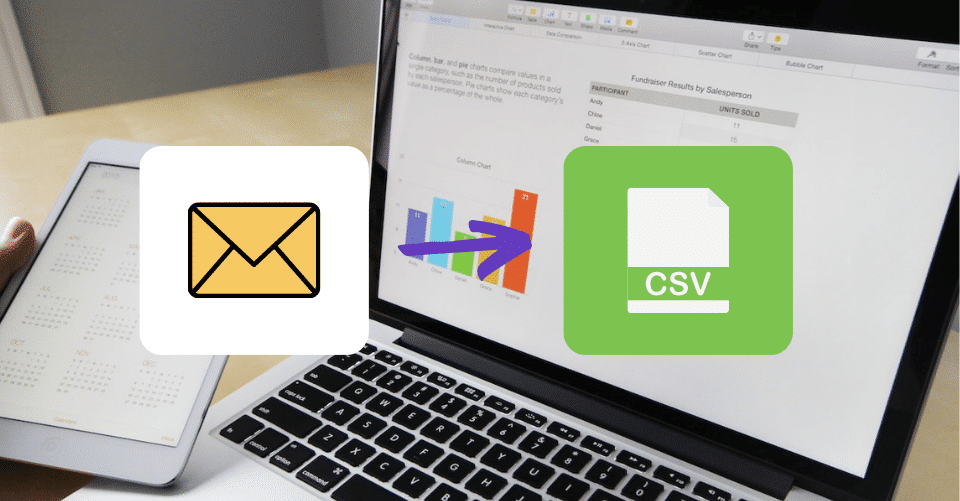Automating the process of exporting data can be one of the best steps you take toward efficiency in your business. You can easily convert PDF to CSV files with automation software saving you time and money. 99% of businesses around the world receive crucial information through their email. In fact, 78% of business owners worldwide check their email as the first thing before getting out of bed in the morning.
However, most businesses don’t make their emails work for them. What we mean here is that by automating the many manual processes, like converting files from PDF to CSV format or exporting Gmail emails to CSV, you will optimize your processes and save time.
Why Extract Email Data to CSV File with Parserr?
Parserr is the best extraction tool you will come across, serving hundreds of businesses. With Parserr, you can export Gmail emails to CSV file format effortlessly. Amongst the benefits of using Parserr is it doesn’t restrict your choice to just a few platforms and file formats. Whether you intend to export email to an MS Excel Spreadsheet or CVS file, our solution will automate your processes.
Save Time and Money With Email To CSV Automation
Most businesses receive repetitive emails from customers with the same or similar content. These emails include website inquiries, new leads or multiple PDF files. Going over such information is time consuming and boring, leaving room for mistakes.
With Parserr, you will save time and resources, as you wouldn’t have to extract information manually. Once you incorporate Parserr into your systems, you will automate numerous processes, including;
- Incoming leads from your email list to Salesforce
- Website inquiries to contact lists
- Confirmations to restaurant POS system
- Using a PDF converter to convert PDF to CSV
What Is CSV File?
A CSV file, also known as a comma separated value file, is a plain text file where tabular data is stored as values separated by commas. CSV formatted files are used to store a wide variety of information and are typically used to display and share important data in spreadsheets or databases.
Numerous users find it convenient to export their emails to CSV because it is a universal file format that makes them easy to access. A CSV file format can be opened by programs such as Microsoft Excel, Google Sheets, Apple Numbers, other spreadsheet applications, database management tools, and even text editors.
How Do You Extract Data from Email to CSV?
Depending on the email provider you use, the process might be somewhat different, but in general, the steps you will need to take to extract data from email to CSV are as follows:
Step 1: Sign Up for A Free Plan with Parserr.
We understand that you might have doubts about whether Parserr is as good as its reputation. For this, we have a free plan where you can have a test drive of what Parserr offers. The free plan allows you to use one email account and parse 15 email messages and 10 documents monthly. Additionally, you will have access to unlimited parsing rules, unlimited integration, and Zapier + Microsoft flow.
Step 2: Create an Incoming Email Address
Set up an email address, such as a Gmail account, for the particular email you’d like to automate. You probably already have one of these, but in case you want to change, you can establish another one.
Step 3: Set Parsing rules.
Parsing rules are what we use to extract data. Our parsing tool can only automate what you instruct it to; therefore, it is paramount to specify your needs. The rules need to reflect how you want to extract your data from your email.
Step 4: Test Your Parsing Rules
Send some test emails to your Parserr email address to test your rules. You can even try to extract emails to CSV to confirm that everything works as expected.
Step 5: Make Necessary Adjustments if Needed
Adjust as needed to extract data you would like from your email or email attachments, such as contact information, pdf files, and more.
We have created a video to show how easy it is to create new parsing rules. You can create multiple rules for each email to extract exactly what you need. Watch below and see how you can parse your incoming email in less than one minute and extract specific data from all your emails.
Once the rules are running, you can set up file downloads, creating a row for every incoming email you send us. You can download the file as and when you need it or have it emailed to you when required.
Can I Export Gmail Emails or Outlook Emails to CSV File Format?
Yes, many of our clients use Gmail and MS Outlook; however, Parserr allows you to parse email data from almost all email client types.
Most Popular Email Applications:
- MS Outlook: Through Zapier, you can connect your Outlook and Parserr applications and quickly extract information from your emails or convert PDFs to CSV files. You can choose to send your emails to an account or a folder so you keep them organized and easy to access.
- Gmail: Through the ‘Filter’ feature in your Gmail account, you can forward any email you want to your Parserr inbox. Once there, you can export Gmail emails data to CSV files. Easily extract and save emails from Gmail.
- Yahoo Mail: Parserr also integrates seamlessly with Yahoo Mail and allows you to manage and automate your inbox to scrape all the data important for your business.
- Zoho: This app allows a quick integration to email parsers like Parserr. With it, you can automatically find essential information in the emails you receive and organize that information in a way that is easy to retrieve.
- AOL: Through our integration with AOL, you can take full advantage of automation to scrape crucial information from the emails you’re getting in your inbox. Scrape data or convert PDFs to CSV files, whatever you need.
- Mail.com: Parse all your essential data directly from email attachments. Regardless of the file format, whether it’s PDF documents, Microsoft Office files, and even a scanned PDF file, you can put them into a CSV file for easy access.
What About EML Files?
Most users are concerned about EML files. EML files are easily readable by email clients like Microsoft Outlook, Mozilla Thunderbird, and others. Drag and drop the EML file into a blank spreadsheet in Microsoft Excel. The email will open in a protected view for security reasons; therefore, the user must enable editing to access the email. Click the save icon to save the CSV file.
Wrapping up
Whether you want to automate your data extractions from email or convert PDF to CSV format, leveraging Parserr automation is very simple. Once you set it up, you will benefit from having clean and organized CSV files or other file formats you may prefer. Your data will be easy to navigate, allowing you to track, find and use exactly what you need at the right time. Parserr doesn’t just export or extract from a single file type but numerous contact records, message details, and other stuff you might need. If you want help with automating your inbox and extracting PDFs to Google Sheets or emails to CSV, contact us on our chat or email us; we’d be happy to help! If you would like more information, you can always check out ourparsing support articles for more detailed walkthroughs.











